Comprehensive Report: Human Resource Planning and Staffing for Chern's
VerifiedAdded on 2020/05/04
|11
|2489
|61
Report
AI Summary
This report provides a comprehensive analysis of human resource planning and staffing, focusing on the case of Chern's. It begins with background information on workforce planning and the five-step process involved. The report then delves into forecasting, emphasizing the identification of key operational factors and the importance of accurate data. It explores forecasting labor demand using methods like scatter plots and ratio analysis, and labor supply by considering both internal and external labor markets. A significant portion of the report is dedicated to transition analysis, offering a practical method for scrutinizing labor markets and predicting internal labor supply. The report addresses strategies for resolving labor supply gaps, including managing temporary and permanent surpluses and shortages. Finally, it concludes with recommendations for Chern's, such as systematically identifying candidate talents and implementing succession management, providing a practical guide for effective workforce planning. The report emphasizes the importance of adapting to changing business environments and consumer preferences.
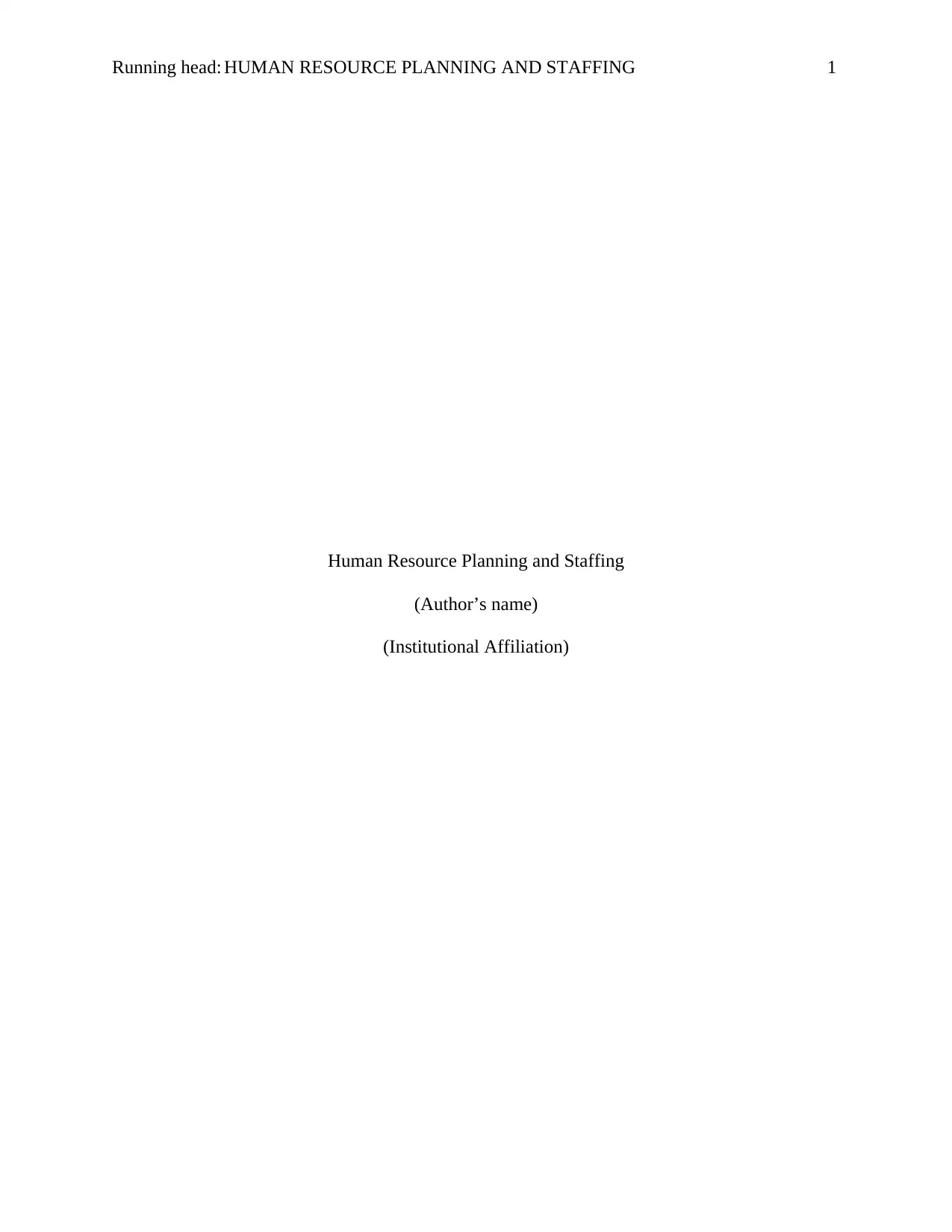
Running head: HUMAN RESOURCE PLANNING AND STAFFING 1
Human Resource Planning and Staffing
(Author’s name)
(Institutional Affiliation)
Human Resource Planning and Staffing
(Author’s name)
(Institutional Affiliation)
Paraphrase This Document
Need a fresh take? Get an instant paraphrase of this document with our AI Paraphraser
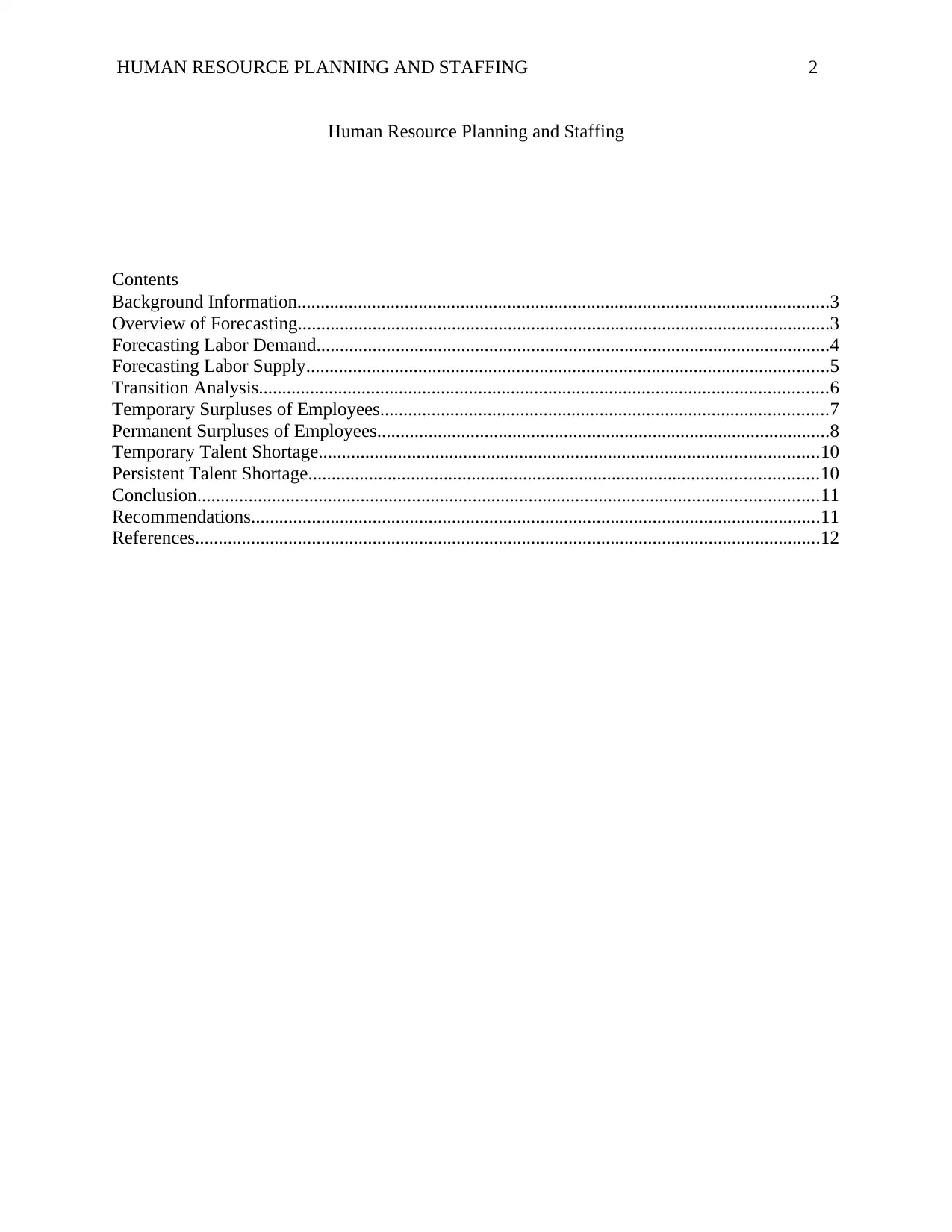
HUMAN RESOURCE PLANNING AND STAFFING 2
Human Resource Planning and Staffing
Contents
Background Information..................................................................................................................3
Overview of Forecasting..................................................................................................................3
Forecasting Labor Demand..............................................................................................................4
Forecasting Labor Supply................................................................................................................5
Transition Analysis..........................................................................................................................6
Temporary Surpluses of Employees................................................................................................7
Permanent Surpluses of Employees.................................................................................................8
Temporary Talent Shortage...........................................................................................................10
Persistent Talent Shortage.............................................................................................................10
Conclusion.....................................................................................................................................11
Recommendations..........................................................................................................................11
References......................................................................................................................................12
Human Resource Planning and Staffing
Contents
Background Information..................................................................................................................3
Overview of Forecasting..................................................................................................................3
Forecasting Labor Demand..............................................................................................................4
Forecasting Labor Supply................................................................................................................5
Transition Analysis..........................................................................................................................6
Temporary Surpluses of Employees................................................................................................7
Permanent Surpluses of Employees.................................................................................................8
Temporary Talent Shortage...........................................................................................................10
Persistent Talent Shortage.............................................................................................................10
Conclusion.....................................................................................................................................11
Recommendations..........................................................................................................................11
References......................................................................................................................................12
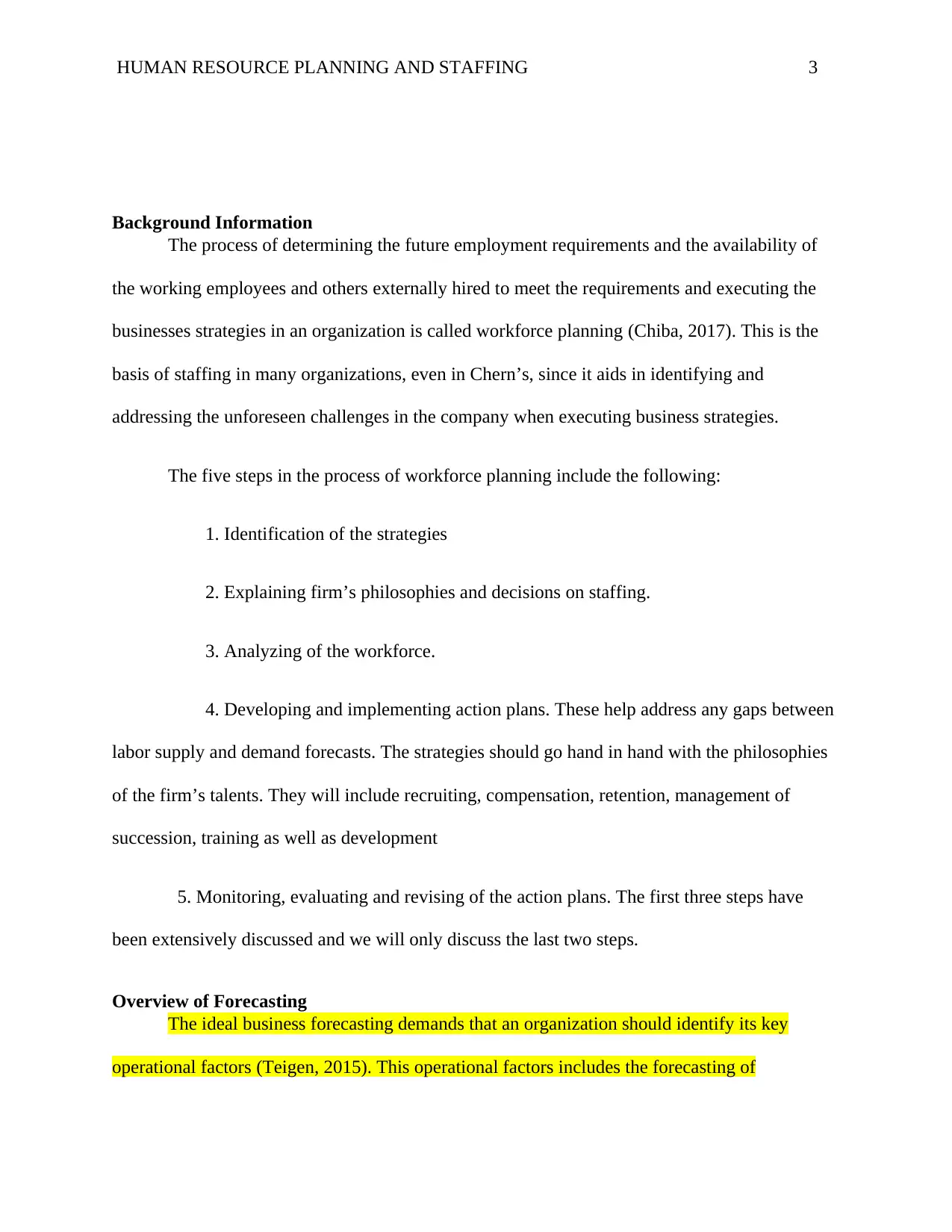
HUMAN RESOURCE PLANNING AND STAFFING 3
Background Information
The process of determining the future employment requirements and the availability of
the working employees and others externally hired to meet the requirements and executing the
businesses strategies in an organization is called workforce planning (Chiba, 2017). This is the
basis of staffing in many organizations, even in Chern’s, since it aids in identifying and
addressing the unforeseen challenges in the company when executing business strategies.
The five steps in the process of workforce planning include the following:
1. Identification of the strategies
2. Explaining firm’s philosophies and decisions on staffing.
3. Analyzing of the workforce.
4. Developing and implementing action plans. These help address any gaps between
labor supply and demand forecasts. The strategies should go hand in hand with the philosophies
of the firm’s talents. They will include recruiting, compensation, retention, management of
succession, training as well as development
5. Monitoring, evaluating and revising of the action plans. The first three steps have
been extensively discussed and we will only discuss the last two steps.
Overview of Forecasting
The ideal business forecasting demands that an organization should identify its key
operational factors (Teigen, 2015). This operational factors includes the forecasting of
Background Information
The process of determining the future employment requirements and the availability of
the working employees and others externally hired to meet the requirements and executing the
businesses strategies in an organization is called workforce planning (Chiba, 2017). This is the
basis of staffing in many organizations, even in Chern’s, since it aids in identifying and
addressing the unforeseen challenges in the company when executing business strategies.
The five steps in the process of workforce planning include the following:
1. Identification of the strategies
2. Explaining firm’s philosophies and decisions on staffing.
3. Analyzing of the workforce.
4. Developing and implementing action plans. These help address any gaps between
labor supply and demand forecasts. The strategies should go hand in hand with the philosophies
of the firm’s talents. They will include recruiting, compensation, retention, management of
succession, training as well as development
5. Monitoring, evaluating and revising of the action plans. The first three steps have
been extensively discussed and we will only discuss the last two steps.
Overview of Forecasting
The ideal business forecasting demands that an organization should identify its key
operational factors (Teigen, 2015). This operational factors includes the forecasting of
⊘ This is a preview!⊘
Do you want full access?
Subscribe today to unlock all pages.

Trusted by 1+ million students worldwide
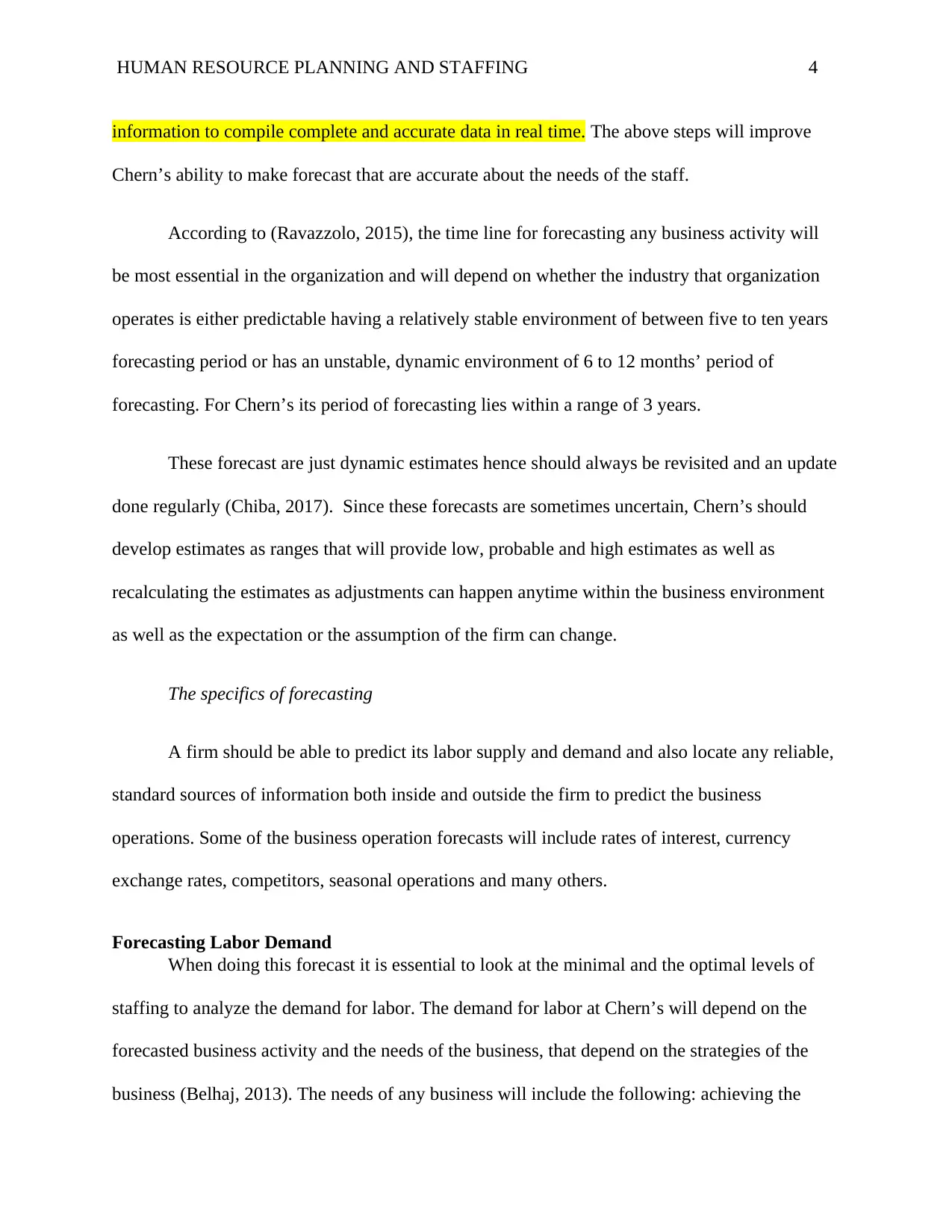
HUMAN RESOURCE PLANNING AND STAFFING 4
information to compile complete and accurate data in real time. The above steps will improve
Chern’s ability to make forecast that are accurate about the needs of the staff.
According to (Ravazzolo, 2015), the time line for forecasting any business activity will
be most essential in the organization and will depend on whether the industry that organization
operates is either predictable having a relatively stable environment of between five to ten years
forecasting period or has an unstable, dynamic environment of 6 to 12 months’ period of
forecasting. For Chern’s its period of forecasting lies within a range of 3 years.
These forecast are just dynamic estimates hence should always be revisited and an update
done regularly (Chiba, 2017). Since these forecasts are sometimes uncertain, Chern’s should
develop estimates as ranges that will provide low, probable and high estimates as well as
recalculating the estimates as adjustments can happen anytime within the business environment
as well as the expectation or the assumption of the firm can change.
The specifics of forecasting
A firm should be able to predict its labor supply and demand and also locate any reliable,
standard sources of information both inside and outside the firm to predict the business
operations. Some of the business operation forecasts will include rates of interest, currency
exchange rates, competitors, seasonal operations and many others.
Forecasting Labor Demand
When doing this forecast it is essential to look at the minimal and the optimal levels of
staffing to analyze the demand for labor. The demand for labor at Chern’s will depend on the
forecasted business activity and the needs of the business, that depend on the strategies of the
business (Belhaj, 2013). The needs of any business will include the following: achieving the
information to compile complete and accurate data in real time. The above steps will improve
Chern’s ability to make forecast that are accurate about the needs of the staff.
According to (Ravazzolo, 2015), the time line for forecasting any business activity will
be most essential in the organization and will depend on whether the industry that organization
operates is either predictable having a relatively stable environment of between five to ten years
forecasting period or has an unstable, dynamic environment of 6 to 12 months’ period of
forecasting. For Chern’s its period of forecasting lies within a range of 3 years.
These forecast are just dynamic estimates hence should always be revisited and an update
done regularly (Chiba, 2017). Since these forecasts are sometimes uncertain, Chern’s should
develop estimates as ranges that will provide low, probable and high estimates as well as
recalculating the estimates as adjustments can happen anytime within the business environment
as well as the expectation or the assumption of the firm can change.
The specifics of forecasting
A firm should be able to predict its labor supply and demand and also locate any reliable,
standard sources of information both inside and outside the firm to predict the business
operations. Some of the business operation forecasts will include rates of interest, currency
exchange rates, competitors, seasonal operations and many others.
Forecasting Labor Demand
When doing this forecast it is essential to look at the minimal and the optimal levels of
staffing to analyze the demand for labor. The demand for labor at Chern’s will depend on the
forecasted business activity and the needs of the business, that depend on the strategies of the
business (Belhaj, 2013). The needs of any business will include the following: achieving the
Paraphrase This Document
Need a fresh take? Get an instant paraphrase of this document with our AI Paraphraser
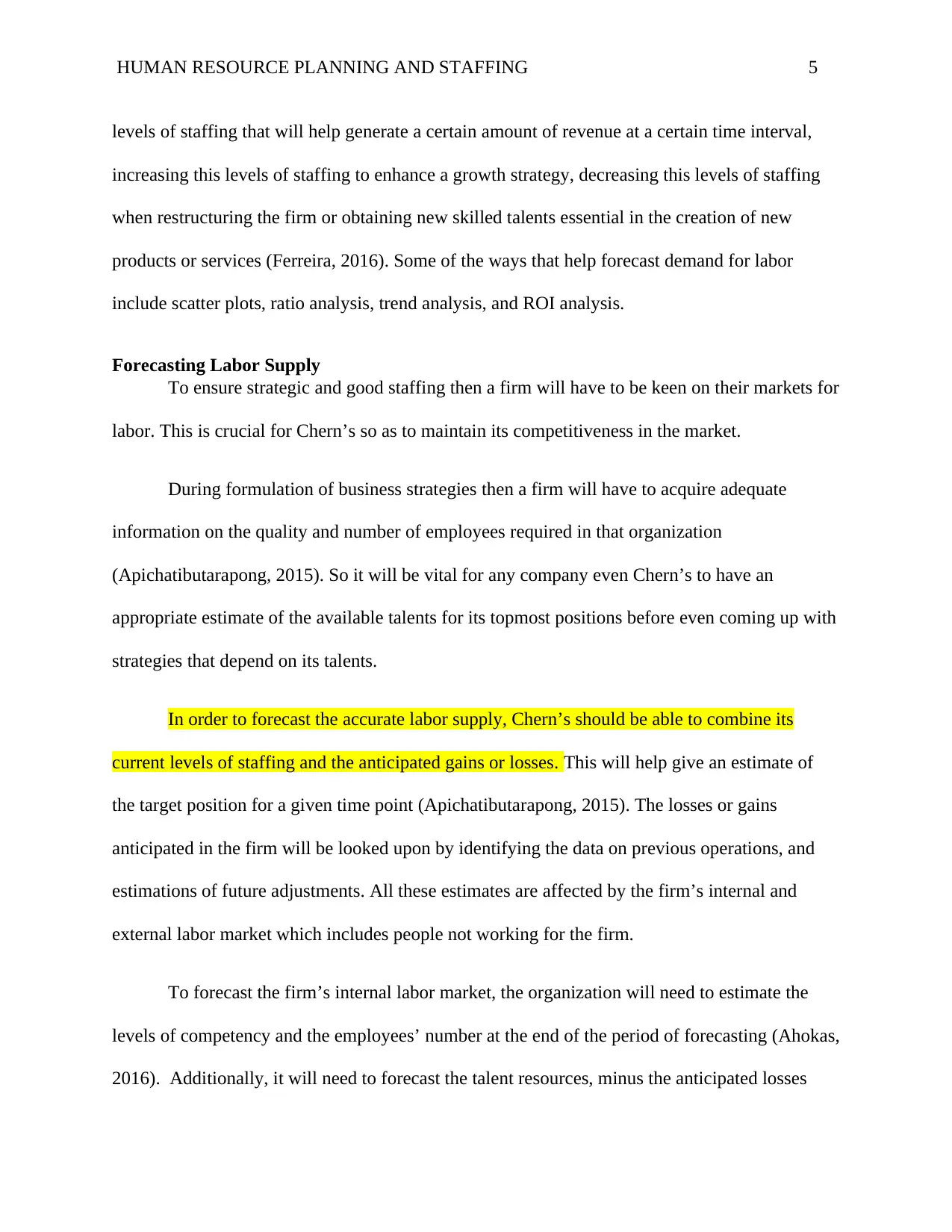
HUMAN RESOURCE PLANNING AND STAFFING 5
levels of staffing that will help generate a certain amount of revenue at a certain time interval,
increasing this levels of staffing to enhance a growth strategy, decreasing this levels of staffing
when restructuring the firm or obtaining new skilled talents essential in the creation of new
products or services (Ferreira, 2016). Some of the ways that help forecast demand for labor
include scatter plots, ratio analysis, trend analysis, and ROI analysis.
Forecasting Labor Supply
To ensure strategic and good staffing then a firm will have to be keen on their markets for
labor. This is crucial for Chern’s so as to maintain its competitiveness in the market.
During formulation of business strategies then a firm will have to acquire adequate
information on the quality and number of employees required in that organization
(Apichatibutarapong, 2015). So it will be vital for any company even Chern’s to have an
appropriate estimate of the available talents for its topmost positions before even coming up with
strategies that depend on its talents.
In order to forecast the accurate labor supply, Chern’s should be able to combine its
current levels of staffing and the anticipated gains or losses. This will help give an estimate of
the target position for a given time point (Apichatibutarapong, 2015). The losses or gains
anticipated in the firm will be looked upon by identifying the data on previous operations, and
estimations of future adjustments. All these estimates are affected by the firm’s internal and
external labor market which includes people not working for the firm.
To forecast the firm’s internal labor market, the organization will need to estimate the
levels of competency and the employees’ number at the end of the period of forecasting (Ahokas,
2016). Additionally, it will need to forecast the talent resources, minus the anticipated losses
levels of staffing that will help generate a certain amount of revenue at a certain time interval,
increasing this levels of staffing to enhance a growth strategy, decreasing this levels of staffing
when restructuring the firm or obtaining new skilled talents essential in the creation of new
products or services (Ferreira, 2016). Some of the ways that help forecast demand for labor
include scatter plots, ratio analysis, trend analysis, and ROI analysis.
Forecasting Labor Supply
To ensure strategic and good staffing then a firm will have to be keen on their markets for
labor. This is crucial for Chern’s so as to maintain its competitiveness in the market.
During formulation of business strategies then a firm will have to acquire adequate
information on the quality and number of employees required in that organization
(Apichatibutarapong, 2015). So it will be vital for any company even Chern’s to have an
appropriate estimate of the available talents for its topmost positions before even coming up with
strategies that depend on its talents.
In order to forecast the accurate labor supply, Chern’s should be able to combine its
current levels of staffing and the anticipated gains or losses. This will help give an estimate of
the target position for a given time point (Apichatibutarapong, 2015). The losses or gains
anticipated in the firm will be looked upon by identifying the data on previous operations, and
estimations of future adjustments. All these estimates are affected by the firm’s internal and
external labor market which includes people not working for the firm.
To forecast the firm’s internal labor market, the organization will need to estimate the
levels of competency and the employees’ number at the end of the period of forecasting (Ahokas,
2016). Additionally, it will need to forecast the talent resources, minus the anticipated losses
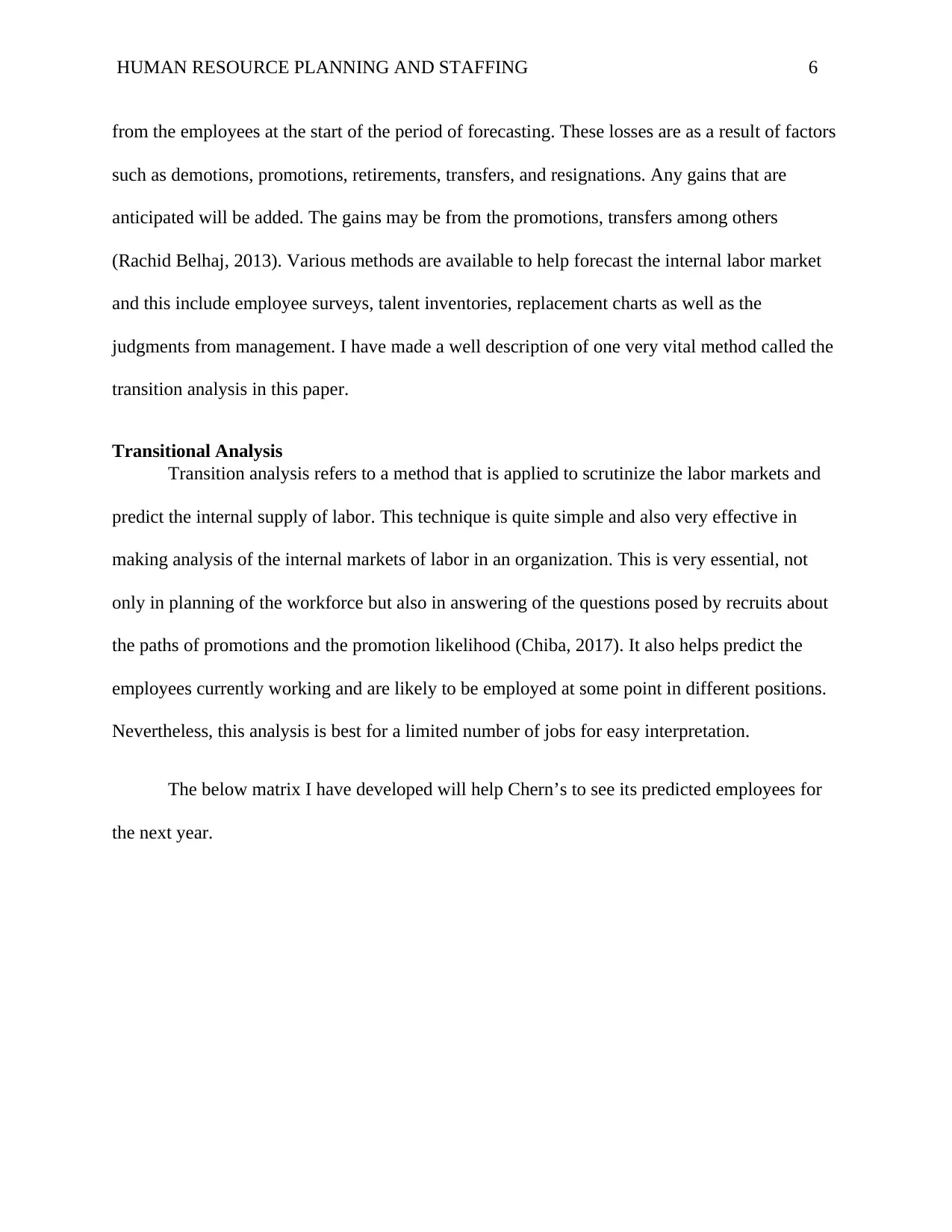
HUMAN RESOURCE PLANNING AND STAFFING 6
from the employees at the start of the period of forecasting. These losses are as a result of factors
such as demotions, promotions, retirements, transfers, and resignations. Any gains that are
anticipated will be added. The gains may be from the promotions, transfers among others
(Rachid Belhaj, 2013). Various methods are available to help forecast the internal labor market
and this include employee surveys, talent inventories, replacement charts as well as the
judgments from management. I have made a well description of one very vital method called the
transition analysis in this paper.
Transitional Analysis
Transition analysis refers to a method that is applied to scrutinize the labor markets and
predict the internal supply of labor. This technique is quite simple and also very effective in
making analysis of the internal markets of labor in an organization. This is very essential, not
only in planning of the workforce but also in answering of the questions posed by recruits about
the paths of promotions and the promotion likelihood (Chiba, 2017). It also helps predict the
employees currently working and are likely to be employed at some point in different positions.
Nevertheless, this analysis is best for a limited number of jobs for easy interpretation.
The below matrix I have developed will help Chern’s to see its predicted employees for
the next year.
from the employees at the start of the period of forecasting. These losses are as a result of factors
such as demotions, promotions, retirements, transfers, and resignations. Any gains that are
anticipated will be added. The gains may be from the promotions, transfers among others
(Rachid Belhaj, 2013). Various methods are available to help forecast the internal labor market
and this include employee surveys, talent inventories, replacement charts as well as the
judgments from management. I have made a well description of one very vital method called the
transition analysis in this paper.
Transitional Analysis
Transition analysis refers to a method that is applied to scrutinize the labor markets and
predict the internal supply of labor. This technique is quite simple and also very effective in
making analysis of the internal markets of labor in an organization. This is very essential, not
only in planning of the workforce but also in answering of the questions posed by recruits about
the paths of promotions and the promotion likelihood (Chiba, 2017). It also helps predict the
employees currently working and are likely to be employed at some point in different positions.
Nevertheless, this analysis is best for a limited number of jobs for easy interpretation.
The below matrix I have developed will help Chern’s to see its predicted employees for
the next year.
⊘ This is a preview!⊘
Do you want full access?
Subscribe today to unlock all pages.

Trusted by 1+ million students worldwide
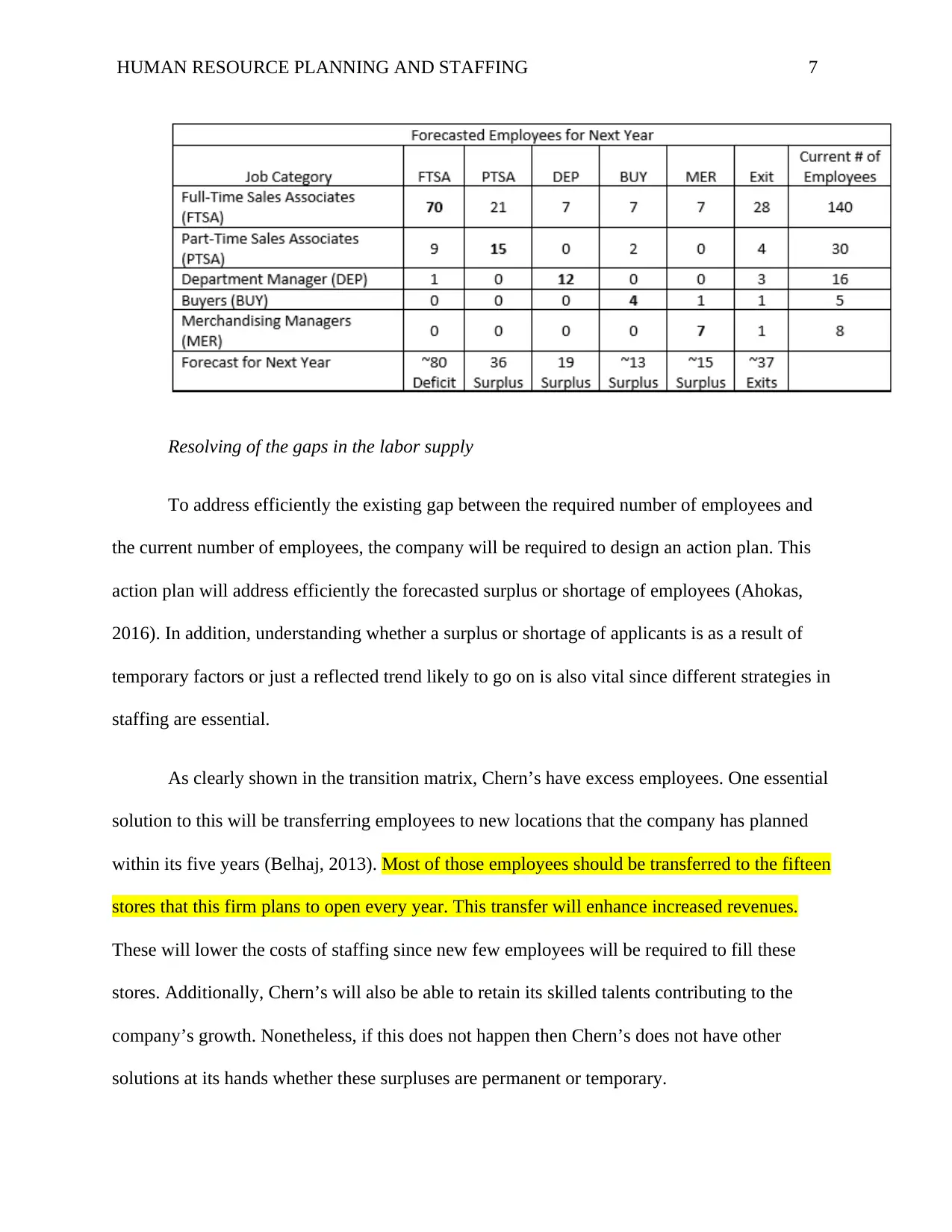
HUMAN RESOURCE PLANNING AND STAFFING 7
Resolving of the gaps in the labor supply
To address efficiently the existing gap between the required number of employees and
the current number of employees, the company will be required to design an action plan. This
action plan will address efficiently the forecasted surplus or shortage of employees (Ahokas,
2016). In addition, understanding whether a surplus or shortage of applicants is as a result of
temporary factors or just a reflected trend likely to go on is also vital since different strategies in
staffing are essential.
As clearly shown in the transition matrix, Chern’s have excess employees. One essential
solution to this will be transferring employees to new locations that the company has planned
within its five years (Belhaj, 2013). Most of those employees should be transferred to the fifteen
stores that this firm plans to open every year. This transfer will enhance increased revenues.
These will lower the costs of staffing since new few employees will be required to fill these
stores. Additionally, Chern’s will also be able to retain its skilled talents contributing to the
company’s growth. Nonetheless, if this does not happen then Chern’s does not have other
solutions at its hands whether these surpluses are permanent or temporary.
Resolving of the gaps in the labor supply
To address efficiently the existing gap between the required number of employees and
the current number of employees, the company will be required to design an action plan. This
action plan will address efficiently the forecasted surplus or shortage of employees (Ahokas,
2016). In addition, understanding whether a surplus or shortage of applicants is as a result of
temporary factors or just a reflected trend likely to go on is also vital since different strategies in
staffing are essential.
As clearly shown in the transition matrix, Chern’s have excess employees. One essential
solution to this will be transferring employees to new locations that the company has planned
within its five years (Belhaj, 2013). Most of those employees should be transferred to the fifteen
stores that this firm plans to open every year. This transfer will enhance increased revenues.
These will lower the costs of staffing since new few employees will be required to fill these
stores. Additionally, Chern’s will also be able to retain its skilled talents contributing to the
company’s growth. Nonetheless, if this does not happen then Chern’s does not have other
solutions at its hands whether these surpluses are permanent or temporary.
Paraphrase This Document
Need a fresh take? Get an instant paraphrase of this document with our AI Paraphraser
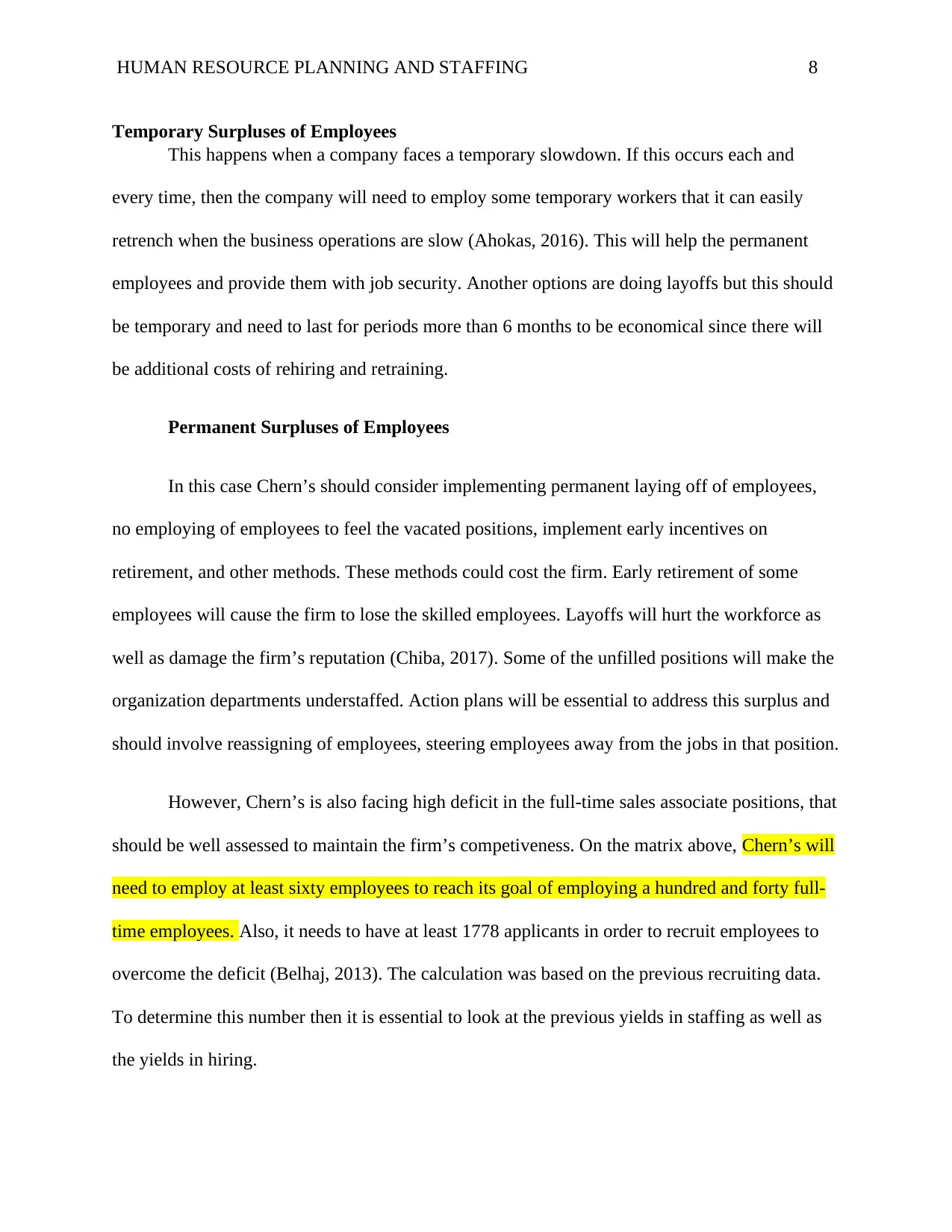
HUMAN RESOURCE PLANNING AND STAFFING 8
Temporary Surpluses of Employees
This happens when a company faces a temporary slowdown. If this occurs each and
every time, then the company will need to employ some temporary workers that it can easily
retrench when the business operations are slow (Ahokas, 2016). This will help the permanent
employees and provide them with job security. Another options are doing layoffs but this should
be temporary and need to last for periods more than 6 months to be economical since there will
be additional costs of rehiring and retraining.
Permanent Surpluses of Employees
In this case Chern’s should consider implementing permanent laying off of employees,
no employing of employees to feel the vacated positions, implement early incentives on
retirement, and other methods. These methods could cost the firm. Early retirement of some
employees will cause the firm to lose the skilled employees. Layoffs will hurt the workforce as
well as damage the firm’s reputation (Chiba, 2017). Some of the unfilled positions will make the
organization departments understaffed. Action plans will be essential to address this surplus and
should involve reassigning of employees, steering employees away from the jobs in that position.
However, Chern’s is also facing high deficit in the full-time sales associate positions, that
should be well assessed to maintain the firm’s competiveness. On the matrix above, Chern’s will
need to employ at least sixty employees to reach its goal of employing a hundred and forty full-
time employees. Also, it needs to have at least 1778 applicants in order to recruit employees to
overcome the deficit (Belhaj, 2013). The calculation was based on the previous recruiting data.
To determine this number then it is essential to look at the previous yields in staffing as well as
the yields in hiring.
Temporary Surpluses of Employees
This happens when a company faces a temporary slowdown. If this occurs each and
every time, then the company will need to employ some temporary workers that it can easily
retrench when the business operations are slow (Ahokas, 2016). This will help the permanent
employees and provide them with job security. Another options are doing layoffs but this should
be temporary and need to last for periods more than 6 months to be economical since there will
be additional costs of rehiring and retraining.
Permanent Surpluses of Employees
In this case Chern’s should consider implementing permanent laying off of employees,
no employing of employees to feel the vacated positions, implement early incentives on
retirement, and other methods. These methods could cost the firm. Early retirement of some
employees will cause the firm to lose the skilled employees. Layoffs will hurt the workforce as
well as damage the firm’s reputation (Chiba, 2017). Some of the unfilled positions will make the
organization departments understaffed. Action plans will be essential to address this surplus and
should involve reassigning of employees, steering employees away from the jobs in that position.
However, Chern’s is also facing high deficit in the full-time sales associate positions, that
should be well assessed to maintain the firm’s competiveness. On the matrix above, Chern’s will
need to employ at least sixty employees to reach its goal of employing a hundred and forty full-
time employees. Also, it needs to have at least 1778 applicants in order to recruit employees to
overcome the deficit (Belhaj, 2013). The calculation was based on the previous recruiting data.
To determine this number then it is essential to look at the previous yields in staffing as well as
the yields in hiring.
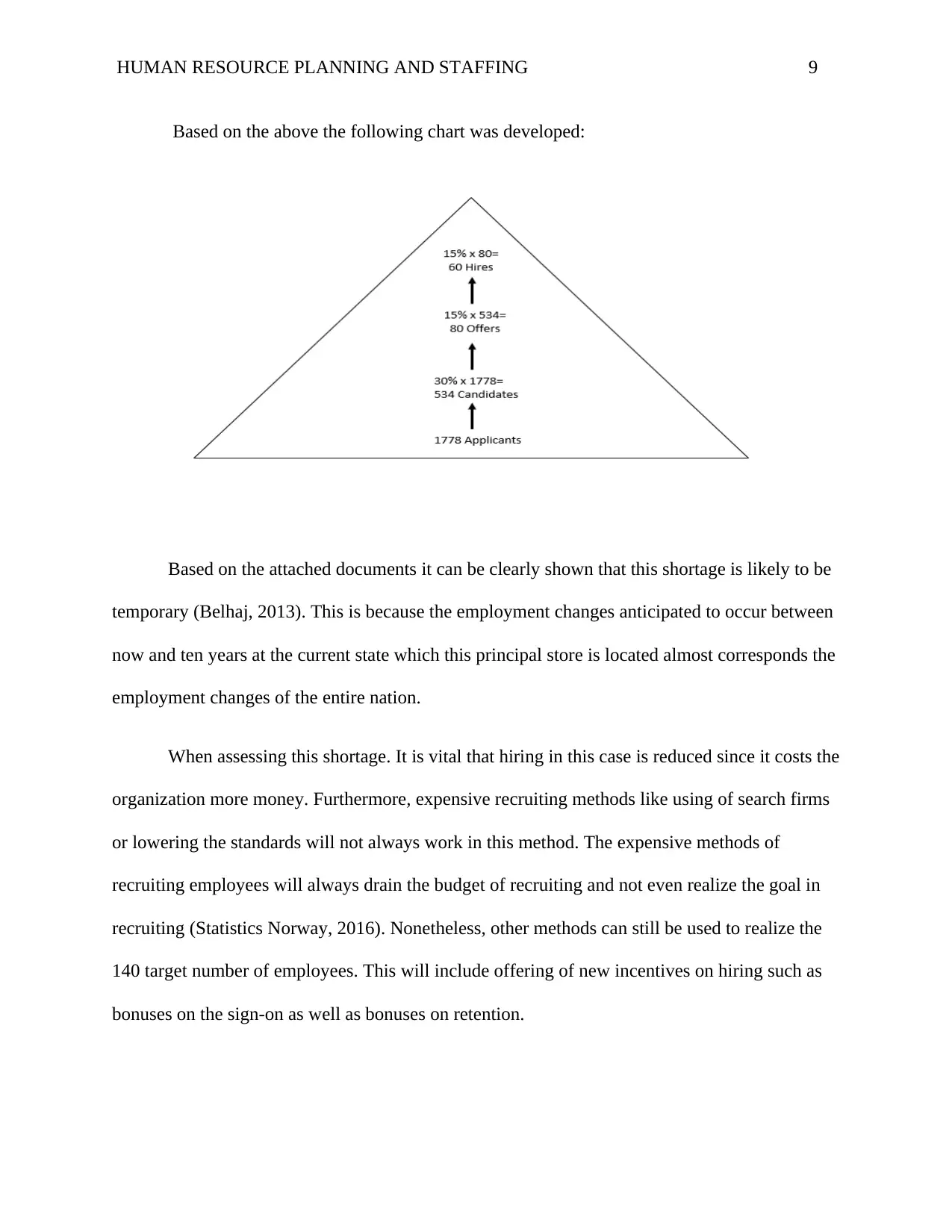
HUMAN RESOURCE PLANNING AND STAFFING 9
Based on the above the following chart was developed:
Based on the attached documents it can be clearly shown that this shortage is likely to be
temporary (Belhaj, 2013). This is because the employment changes anticipated to occur between
now and ten years at the current state which this principal store is located almost corresponds the
employment changes of the entire nation.
When assessing this shortage. It is vital that hiring in this case is reduced since it costs the
organization more money. Furthermore, expensive recruiting methods like using of search firms
or lowering the standards will not always work in this method. The expensive methods of
recruiting employees will always drain the budget of recruiting and not even realize the goal in
recruiting (Statistics Norway, 2016). Nonetheless, other methods can still be used to realize the
140 target number of employees. This will include offering of new incentives on hiring such as
bonuses on the sign-on as well as bonuses on retention.
Based on the above the following chart was developed:
Based on the attached documents it can be clearly shown that this shortage is likely to be
temporary (Belhaj, 2013). This is because the employment changes anticipated to occur between
now and ten years at the current state which this principal store is located almost corresponds the
employment changes of the entire nation.
When assessing this shortage. It is vital that hiring in this case is reduced since it costs the
organization more money. Furthermore, expensive recruiting methods like using of search firms
or lowering the standards will not always work in this method. The expensive methods of
recruiting employees will always drain the budget of recruiting and not even realize the goal in
recruiting (Statistics Norway, 2016). Nonetheless, other methods can still be used to realize the
140 target number of employees. This will include offering of new incentives on hiring such as
bonuses on the sign-on as well as bonuses on retention.
⊘ This is a preview!⊘
Do you want full access?
Subscribe today to unlock all pages.

Trusted by 1+ million students worldwide
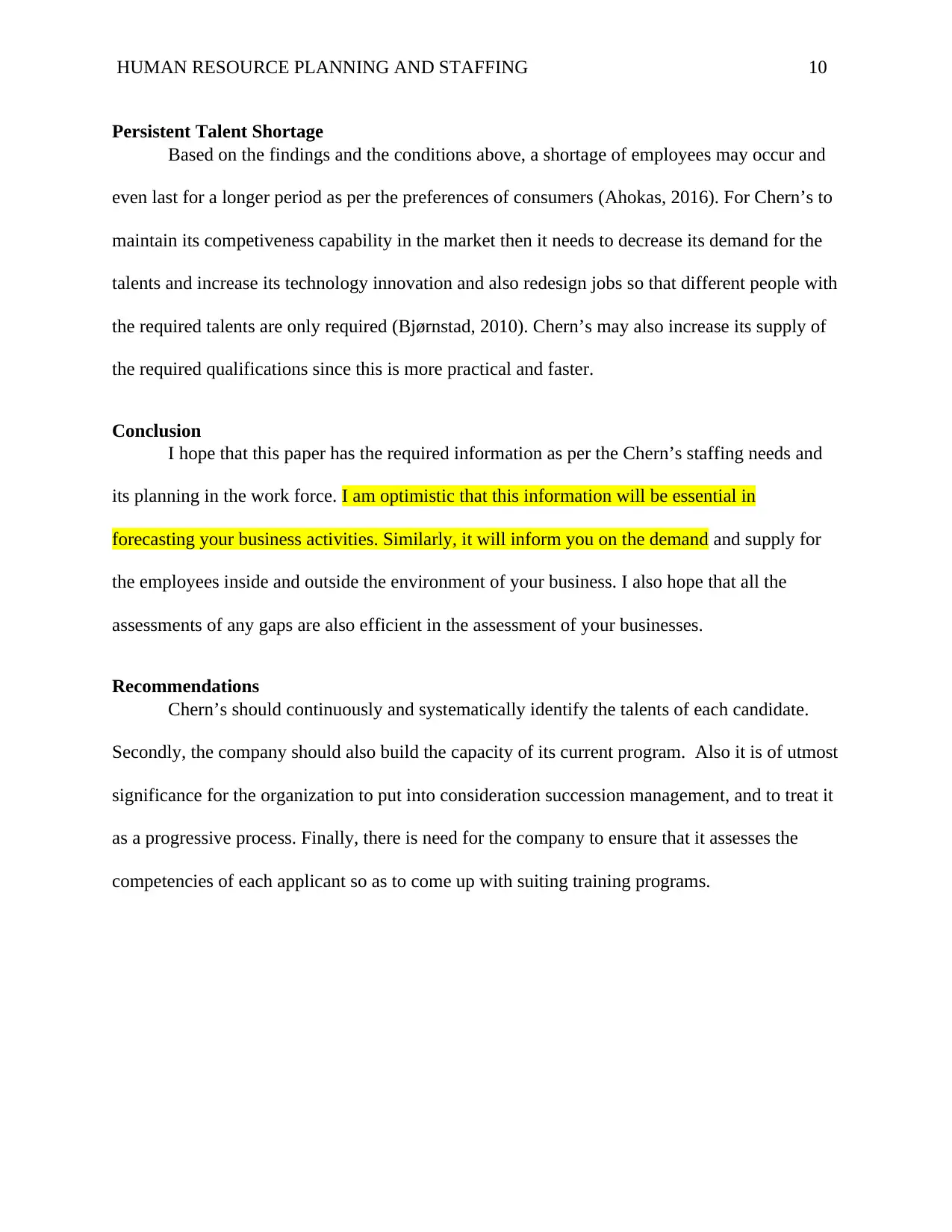
HUMAN RESOURCE PLANNING AND STAFFING 10
Persistent Talent Shortage
Based on the findings and the conditions above, a shortage of employees may occur and
even last for a longer period as per the preferences of consumers (Ahokas, 2016). For Chern’s to
maintain its competiveness capability in the market then it needs to decrease its demand for the
talents and increase its technology innovation and also redesign jobs so that different people with
the required talents are only required (Bjørnstad, 2010). Chern’s may also increase its supply of
the required qualifications since this is more practical and faster.
Conclusion
I hope that this paper has the required information as per the Chern’s staffing needs and
its planning in the work force. I am optimistic that this information will be essential in
forecasting your business activities. Similarly, it will inform you on the demand and supply for
the employees inside and outside the environment of your business. I also hope that all the
assessments of any gaps are also efficient in the assessment of your businesses.
Recommendations
Chern’s should continuously and systematically identify the talents of each candidate.
Secondly, the company should also build the capacity of its current program. Also it is of utmost
significance for the organization to put into consideration succession management, and to treat it
as a progressive process. Finally, there is need for the company to ensure that it assesses the
competencies of each applicant so as to come up with suiting training programs.
Persistent Talent Shortage
Based on the findings and the conditions above, a shortage of employees may occur and
even last for a longer period as per the preferences of consumers (Ahokas, 2016). For Chern’s to
maintain its competiveness capability in the market then it needs to decrease its demand for the
talents and increase its technology innovation and also redesign jobs so that different people with
the required talents are only required (Bjørnstad, 2010). Chern’s may also increase its supply of
the required qualifications since this is more practical and faster.
Conclusion
I hope that this paper has the required information as per the Chern’s staffing needs and
its planning in the work force. I am optimistic that this information will be essential in
forecasting your business activities. Similarly, it will inform you on the demand and supply for
the employees inside and outside the environment of your business. I also hope that all the
assessments of any gaps are also efficient in the assessment of your businesses.
Recommendations
Chern’s should continuously and systematically identify the talents of each candidate.
Secondly, the company should also build the capacity of its current program. Also it is of utmost
significance for the organization to put into consideration succession management, and to treat it
as a progressive process. Finally, there is need for the company to ensure that it assesses the
competencies of each applicant so as to come up with suiting training programs.
Paraphrase This Document
Need a fresh take? Get an instant paraphrase of this document with our AI Paraphraser
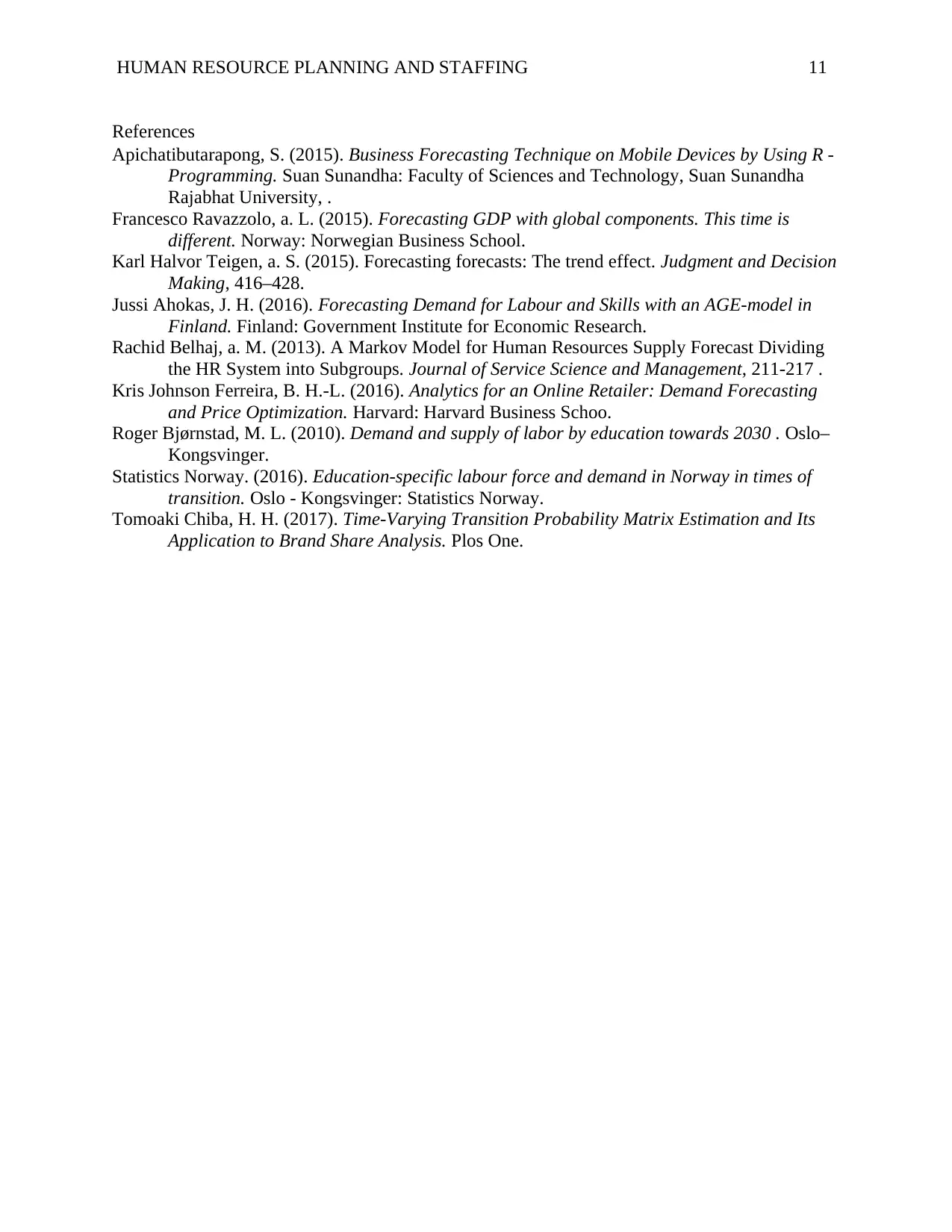
HUMAN RESOURCE PLANNING AND STAFFING 11
References
Apichatibutarapong, S. (2015). Business Forecasting Technique on Mobile Devices by Using R -
Programming. Suan Sunandha: Faculty of Sciences and Technology, Suan Sunandha
Rajabhat University, .
Francesco Ravazzolo, a. L. (2015). Forecasting GDP with global components. This time is
different. Norway: Norwegian Business School.
Karl Halvor Teigen, a. S. (2015). Forecasting forecasts: The trend effect. Judgment and Decision
Making, 416–428.
Jussi Ahokas, J. H. (2016). Forecasting Demand for Labour and Skills with an AGE-model in
Finland. Finland: Government Institute for Economic Research.
Rachid Belhaj, a. M. (2013). A Markov Model for Human Resources Supply Forecast Dividing
the HR System into Subgroups. Journal of Service Science and Management, 211-217 .
Kris Johnson Ferreira, B. H.-L. (2016). Analytics for an Online Retailer: Demand Forecasting
and Price Optimization. Harvard: Harvard Business Schoo.
Roger Bjørnstad, M. L. (2010). Demand and supply of labor by education towards 2030 . Oslo–
Kongsvinger.
Statistics Norway. (2016). Education-specific labour force and demand in Norway in times of
transition. Oslo - Kongsvinger: Statistics Norway.
Tomoaki Chiba, H. H. (2017). Time-Varying Transition Probability Matrix Estimation and Its
Application to Brand Share Analysis. Plos One.
References
Apichatibutarapong, S. (2015). Business Forecasting Technique on Mobile Devices by Using R -
Programming. Suan Sunandha: Faculty of Sciences and Technology, Suan Sunandha
Rajabhat University, .
Francesco Ravazzolo, a. L. (2015). Forecasting GDP with global components. This time is
different. Norway: Norwegian Business School.
Karl Halvor Teigen, a. S. (2015). Forecasting forecasts: The trend effect. Judgment and Decision
Making, 416–428.
Jussi Ahokas, J. H. (2016). Forecasting Demand for Labour and Skills with an AGE-model in
Finland. Finland: Government Institute for Economic Research.
Rachid Belhaj, a. M. (2013). A Markov Model for Human Resources Supply Forecast Dividing
the HR System into Subgroups. Journal of Service Science and Management, 211-217 .
Kris Johnson Ferreira, B. H.-L. (2016). Analytics for an Online Retailer: Demand Forecasting
and Price Optimization. Harvard: Harvard Business Schoo.
Roger Bjørnstad, M. L. (2010). Demand and supply of labor by education towards 2030 . Oslo–
Kongsvinger.
Statistics Norway. (2016). Education-specific labour force and demand in Norway in times of
transition. Oslo - Kongsvinger: Statistics Norway.
Tomoaki Chiba, H. H. (2017). Time-Varying Transition Probability Matrix Estimation and Its
Application to Brand Share Analysis. Plos One.
1 out of 11
Related Documents
Your All-in-One AI-Powered Toolkit for Academic Success.
+13062052269
info@desklib.com
Available 24*7 on WhatsApp / Email
![[object Object]](/_next/static/media/star-bottom.7253800d.svg)
Unlock your academic potential
Copyright © 2020–2025 A2Z Services. All Rights Reserved. Developed and managed by ZUCOL.




